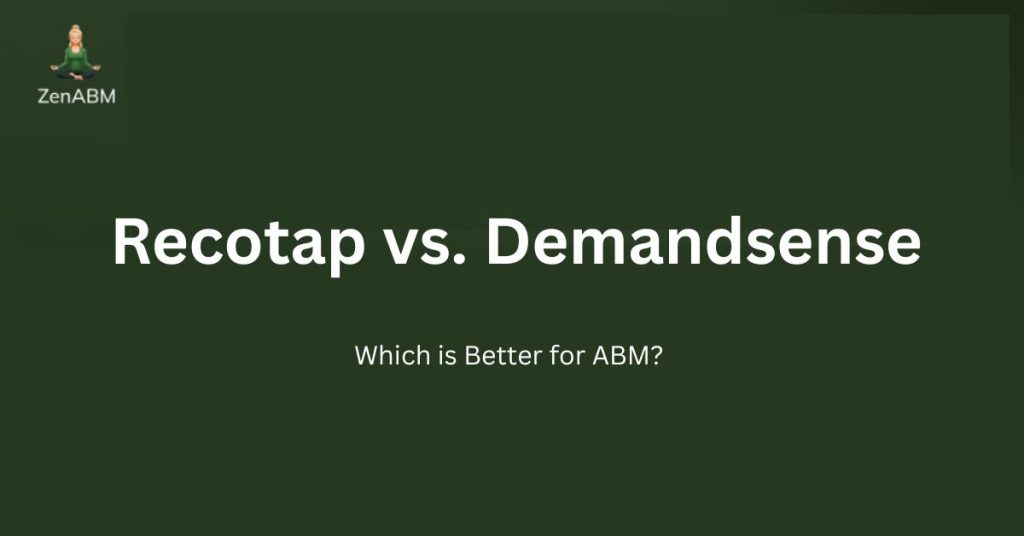Recotap presents itself as a LinkedIn-first ABM platform for B2B teams that want to identify, engage and convert high-value accounts with more precision.
DemandSense, similarly, markets itself as a LinkedIn-centric account-based marketing and demand gen platform for B2B marketers and agencies.
In this guide, I compare Recotap vs. Demandsense on features, pricing and ABM fit so marketing and sales teams can quickly see which platform lines up with their motion.
I also cover how ZenABM can work as a better alternative or serve as a complementary layer due to its unique features.

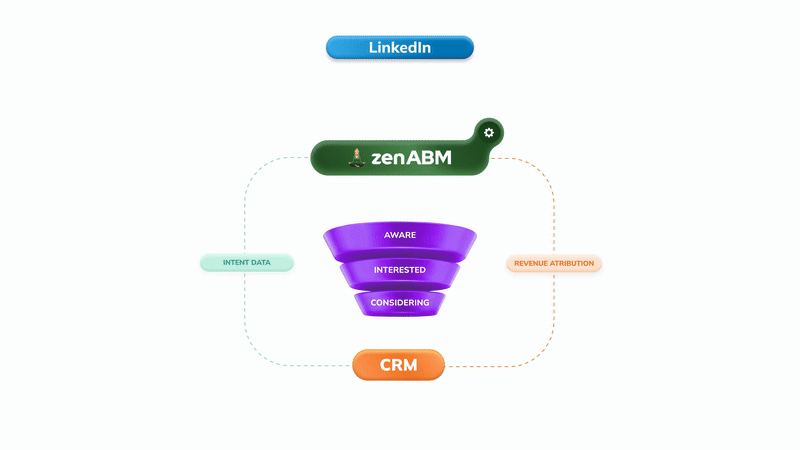
Recotap vs. DemandSense: Quick Summary
In case you’re short on time, here is the snapshot:
- Recotap is a LinkedIn first ABM platform that unifies data, LinkedIn ads, website personalization and revenue analytics.
- DemandSense is a LinkedIn-centric demand gen and optimization tool focused on campaign controls, visitor ID and cross-channel retargeting.
- Recotap runs an ABM Signal Hub that merges CRM, MAP, website behavior and external intent (Bombora, G2, TrustRadius) into one account view with journey staging.
- DemandSense focuses on website visitor identification and LinkedIn-sourced intent, using scripts and IP style matching to reveal which companies visit and engage.
- Recotap is strongest on LinkedIn Ads, plus 1-to-1 landing pages and broader ABM orchestration.
- DemandSense is strongest on LinkedIn campaign tuning, scheduling, frequency capping and extending those account lists into other channels.
- Recotap automates segment refreshes, journey stage estimates and triggers campaigns as intent spikes.
- DemandSense automates ad scheduling, budget shifts, caps per account and hourly optimization on top of Campaign Manager.
- Recotap Standard starts at about 1,499 dollars per month on annual billing, with Enterprise custom.
- DemandSense Basic costs around 99 dollars per month, and at 149 dollars per month, but Website Visitor ID is credit-based and can scale costs.
- Recotap fits teams that want a full ABM suite around LinkedIn, plus web personalization and deeper intent orchestration.
- DemandSense fits teams that already run LinkedIn and just want sharper control, visitor reveal and some cross-channel reuse of those audiences.
- A third option: ZenABM gives account-level LinkedIn ad engagement, pipeline dashboards, account scoring, ABM stages, CRM sync, first-party qualitative intent, automated BDR assignment, custom webhooks, an AI chatbot and job title analytics starting at $59 per month.
Recotap Overview: Key Features, Pricing, and Reviews
Recotap presents itself as a LinkedIn first ABM platform for B2B teams that want to identify, engage and convert high-value accounts with more precision.
Key Features
Recotap is an all-in-one ABM system that covers data, advertising, web experience and analytics.
Unified Data and Targeting
Recotap pulls data from your CRM, marketing automation, website and third-party intent providers into a single account view.
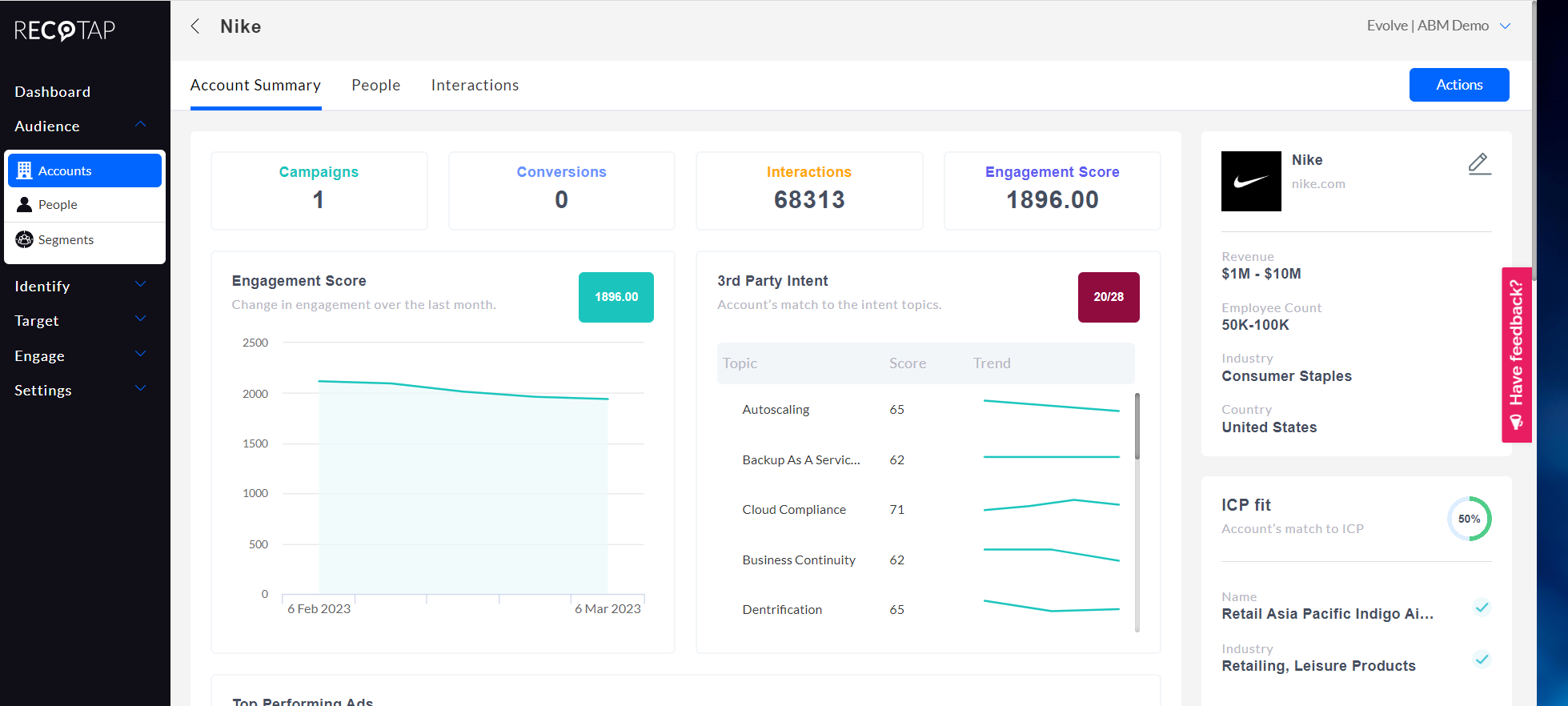
In practice, it joins signals like site visits, ad clicks, external intent (Bombora, G2, TrustRadius) and CRM data so you can segment and score accounts by fit and activity.
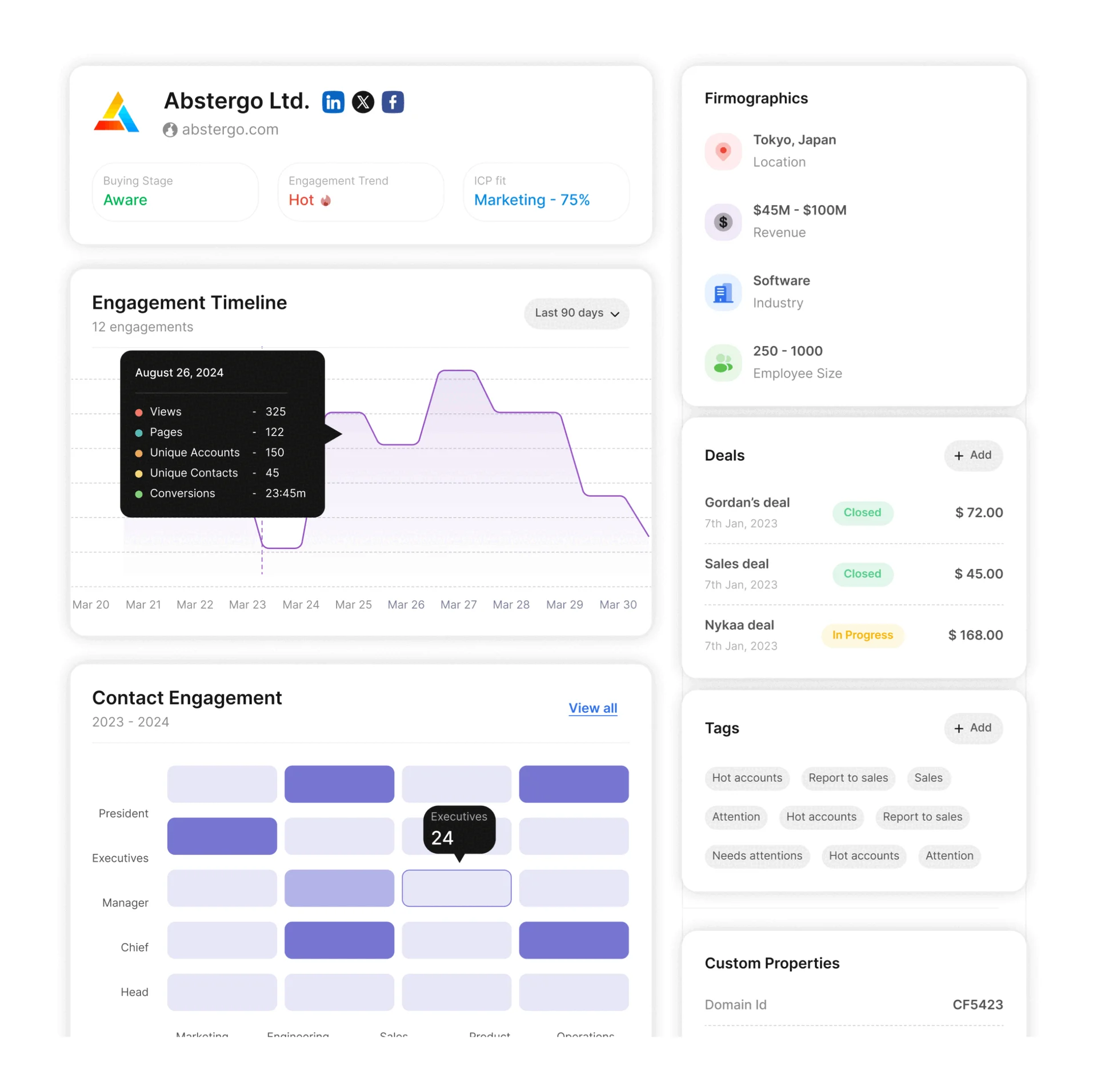
The aim is to understand where each account is in its buying journey and point campaigns at those that match timing and fit.
Account Segmentation & AI Automation
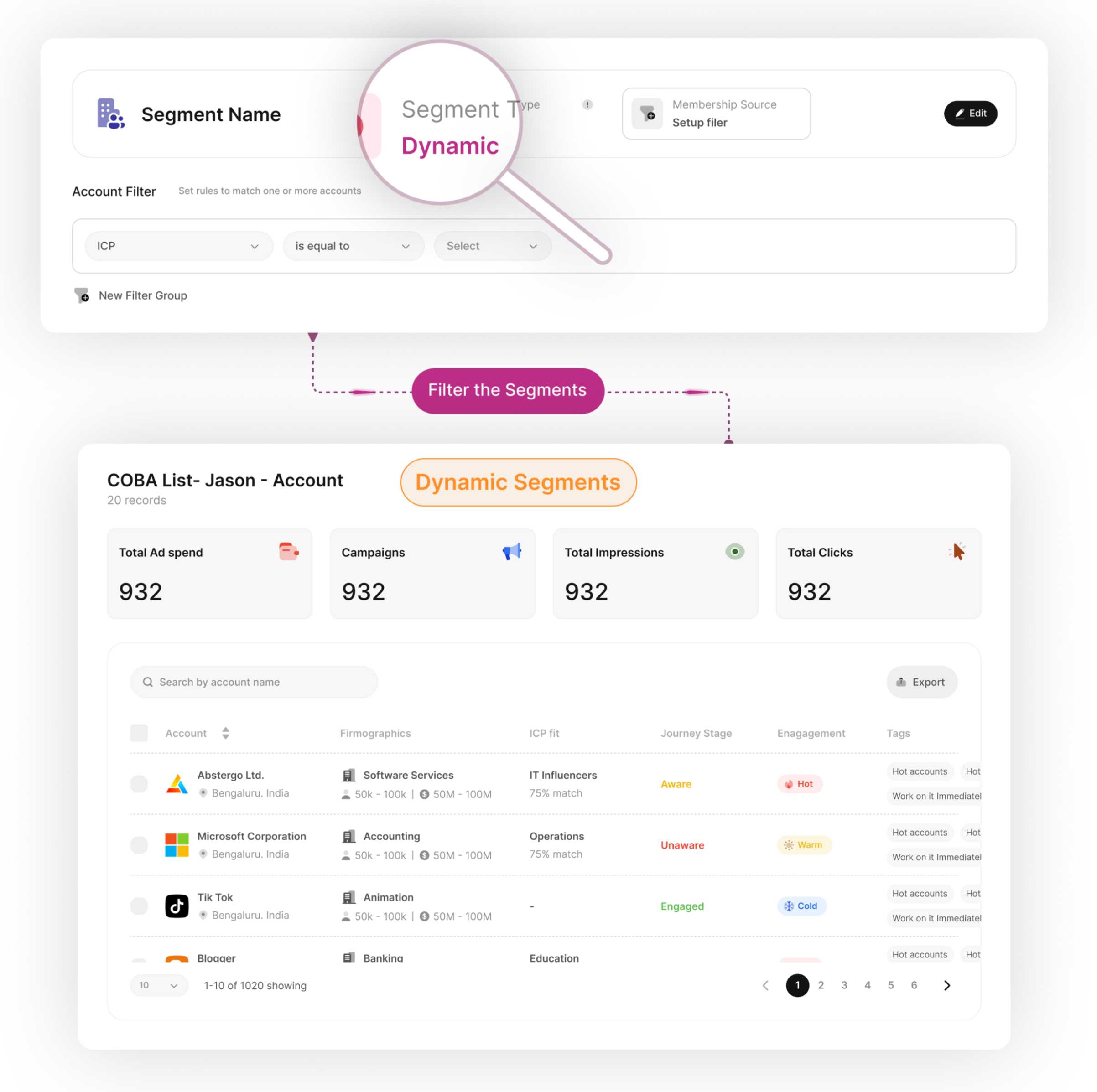
Recotap leans on dynamic segments and AI scoring. You define segments using firmographics, engagement, ICP fit and intent level, and the system keeps these lists refreshed automatically as data changes.
This cuts down manual work on target account lists. Recotap’s AI can also estimate journey stages so you know if an account is early research, actively engaged or close to sales.
LinkedIn Advertising Orchestration
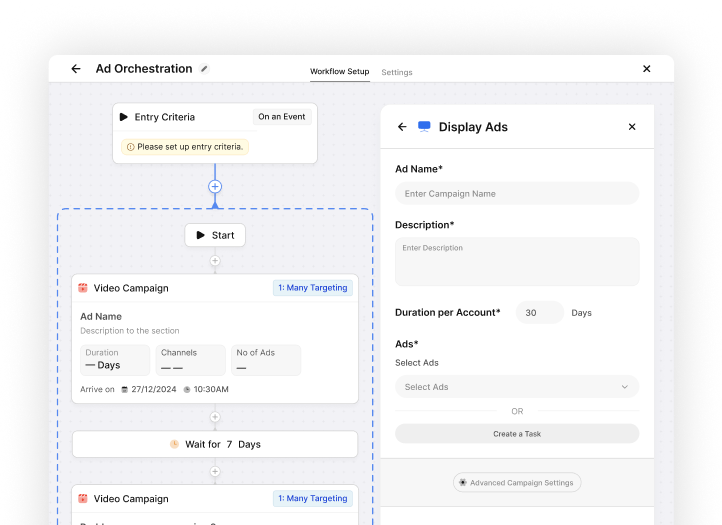
As an official LinkedIn Marketing Partner, Recotap is built for advanced LinkedIn Ads management.
It supports account based LinkedIn campaigns and helps marketers roll out highly tailored LinkedIn ads for dozens or hundreds of accounts at once.
Website Personalization
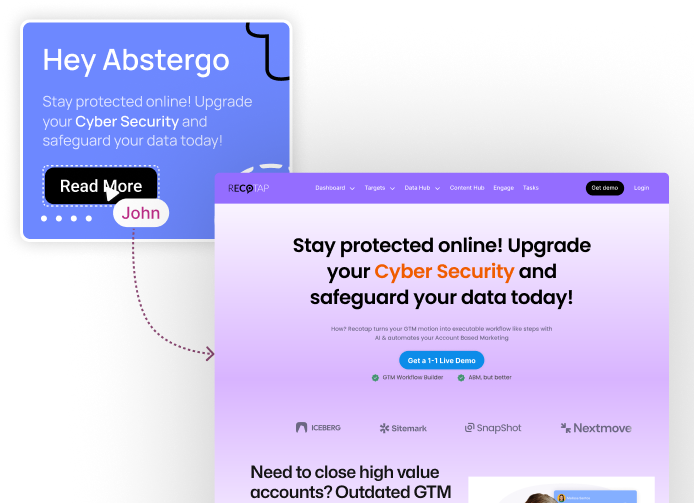
Recotap extends personalization to your website. You can set up 1:1 landing page experiences for target accounts without heavy engineering, putting it closer to web personalization modules in tools like Terminus or Demandbase.
CRM & MAP Integrations
Recotap integrates with major CRM and marketing automation platforms so sales and marketing can work from shared data.
Salesforce and HubSpot CRM are supported with bi-directional sync for accounts, contacts and deals, alongside Marketo and Pardot for marketing automation.
It also connects to sales tools like Outreach and Salesloft, plus Slack and Microsoft Teams, so BDRs get alerts when a target account crosses a threshold.
Analytics & Attribution
Recotap includes AI-powered analytics and revenue attribution dashboards.
Its Revenue Impact view links campaigns to pipeline and revenue so you can see which programs drive closed deals and how account journeys progress from first touch to conversion.
“Smart” Automations
Recotap automates repetitive ABM tasks so lean teams can still run complex programs.
It tracks intent spikes, refreshes segments and triggers outreach when an account hits a hot score. One G2 reviewer notes that Recotap’s UX is built to simplify ABM without sacrificing outcomes.
Data & Intent: Fueling Recotap’s Campaigns
Recotap’s main differentiator is how it merges and interprets intent data to run smarter ABM campaigns.
Its ABM Signal Hub blends first-party engagement data from CRM, website and marketing tools with third-party intent from G2, TrustRadius and Bombora, removing data silos and giving a more complete view of each account.
The intent scoring engine aggregates these signals, ranks accounts by readiness and pushes hot ones into campaigns or sales queues. Because sync is real-time, Recotap can trigger LinkedIn ad sequences as soon as an account shows buying behavior.
The upside is precise targeting with less manual monitoring, though the flexibility introduces some complexity. Reviewers say that once configured, intent orchestration feels close to what you get in tools like 6sense or Demandbase.
Recotap Pricing: How Much Does It Cost?
Recotap publishes pricing on its site, which makes budgeting easier.
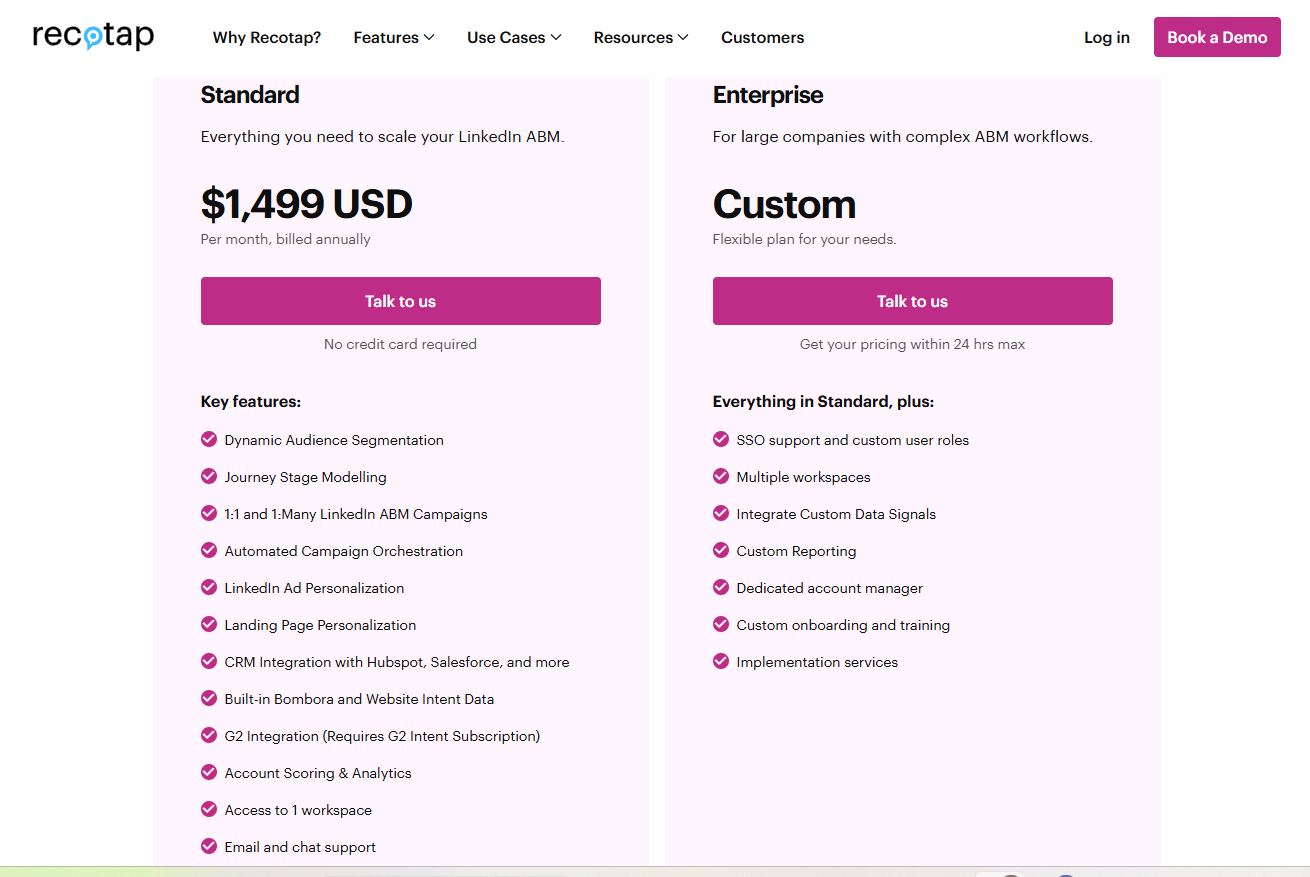
- Standard Plan ($1,499/mo, annual) – Includes: 1:1 and 1:Many LinkedIn ABM campaigns with automated orchestration, dynamic segmentation and journey modeling, hyper personalized LinkedIn ads and landing pages, CRM integrations, Bombora intent and optional G2 data, plus account scoring and analytics for one workspace.
- Enterprise Plan (Custom) – Adds: SSO and custom roles, multiple workspaces, custom data signal integrations and advanced reporting, plus a dedicated account manager and tailored onboarding.
Given that Recotap’s entry plan already comes in above $10K per year, ZenABM stands out as a more budget-friendly option, starting at ~$59/month for the Starter plan, with the top tier still under $6K per year.
ZenABM still covers core LinkedIn ABM needs such as account-level ad engagement tracking, account scoring, ABM stage tracking, routing hot accounts to BDRs, bi-directional CRM sync, custom webhooks, qualitative company intent and plug and play ROI dashboards.

User Impressions and Reviews
Recotap holds a 4.7 out of 5 rating on G2 from 47 reviews.

Most reviewers are based in Asia, which hints that Recotap’s GTM motion is currently APAC heavy.
Users often praise:
- Ease of use and clean UI
- All in one coverage across ads and ABM programs
- Ad management and ABM orchestration
Common issues include:
- Design constraints
- Reporting depth that could be richer in some areas
TrustRadius and other review platforms are still relatively quiet on Recotap.
DemandSense Overview: Key Features, Pricing, and Reviews
DemandSense presents itself as a LinkedIn-centric account-based marketing and demand gen platform for B2B marketers and agencies.
It combines LinkedIn ad optimization, intent data, and prospecting so you can unmask visitors, capture buying intent, and adjust budgets, schedules, and targeting.
Key Features of DemandSense
DemandSense blends several capabilities into one growth platform.
Intent Signal Ingestion
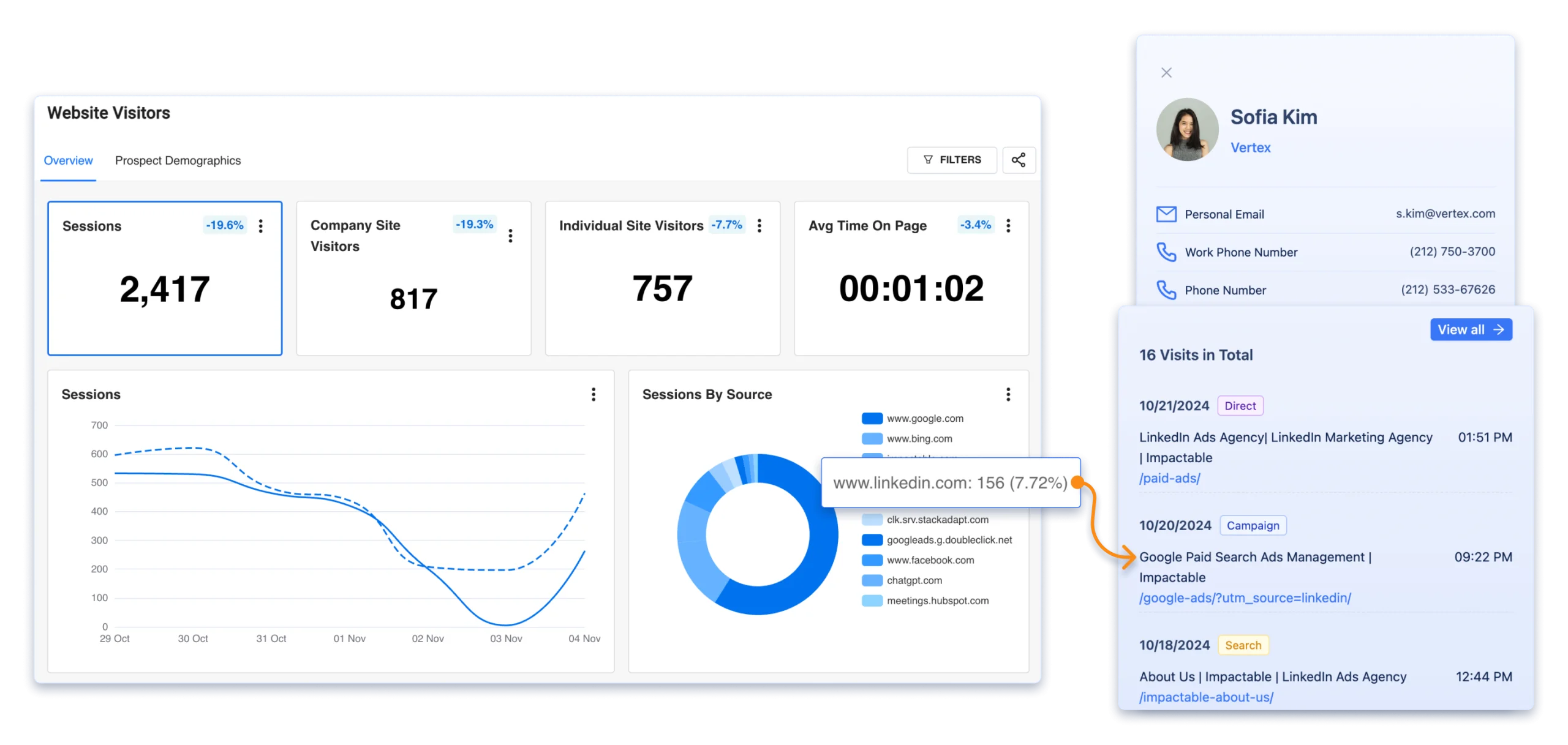
DemandSense aims to unmask anonymous website visitors and identify companies showing buying interest.
Its Visitor ID or IntentID uses LinkedIn data and site tracking scripts to match ad clicks and visits back to firms, then pushes that data into audiences and your CRM.
A G2 user says they can see which companies visit before forms are filled and use that as a clear engagement signal.
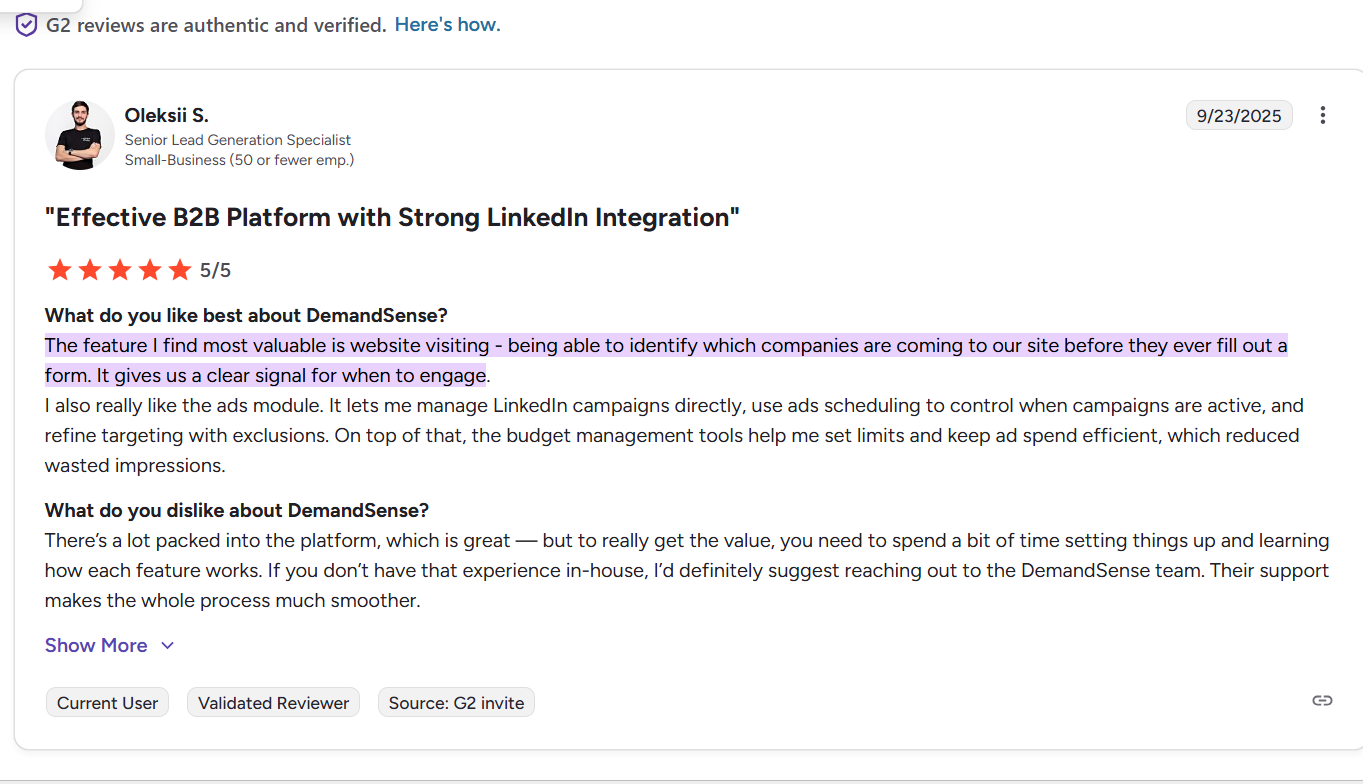
Note: Website visitor deanonymization still leans on IP matching and cookies, which are fragile. Remote work, private networks, unregistered IPs, and aging databases hurt accuracy. Cookies are also being phased out. A Syft study puts IP-based identification at about 42 percent accuracy.

Account-Level Audience Building & Segmentation
Once signals are in, you can group accounts by intent and engagement and build firmographic or behavioral audiences.
DemandSense supports custom lists for LinkedIn retargeting (and other channels), lets you exclude weak segments, and caps impressions per account so large accounts do not get spammed.
LinkedIn-Centric Campaign Management
DemandSense sits on top of Campaign Manager to provide stronger ad controls without heavy complexity.
It auto-tunes LinkedIn campaigns with features like:
- Advanced scheduling: Hourly performance analysis with automatic pauses during low engagement hours.
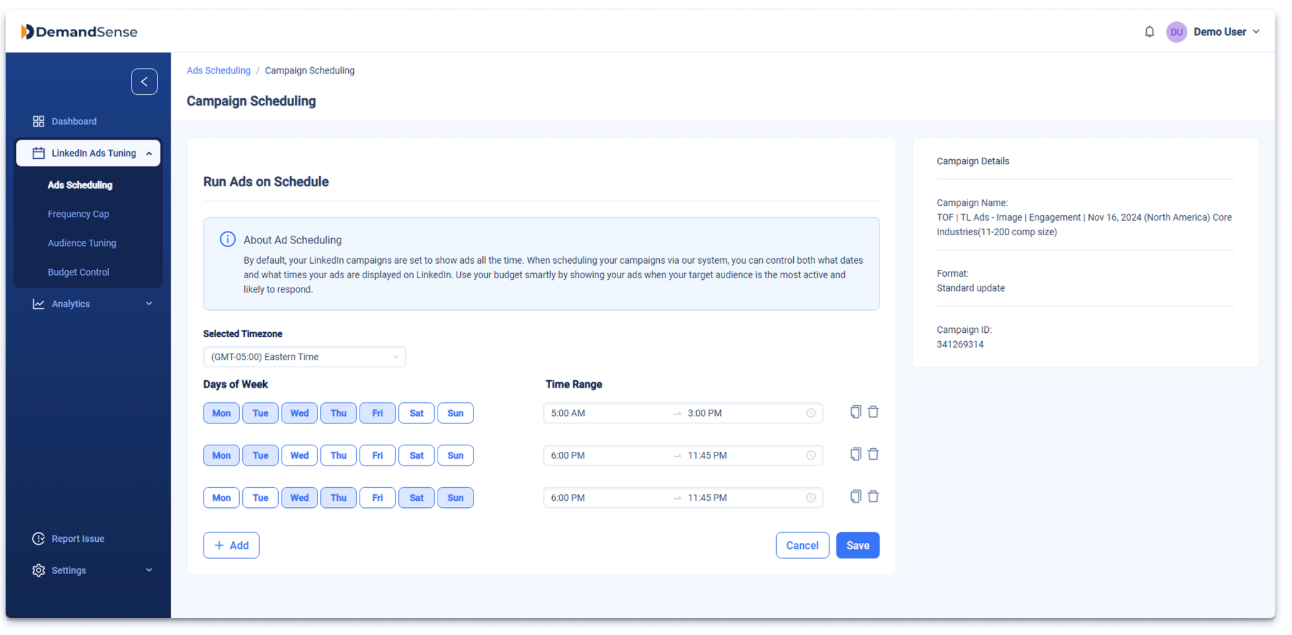
LinkedIn ad campaign scheduling in DemandSense - Smart budgeting: Budget caps and thresholds at the account or campaign level, with spend shifted into high-performing segments and alerts when caps are hit.
- Frequency capping: Per company view or click caps to limit fatigue.
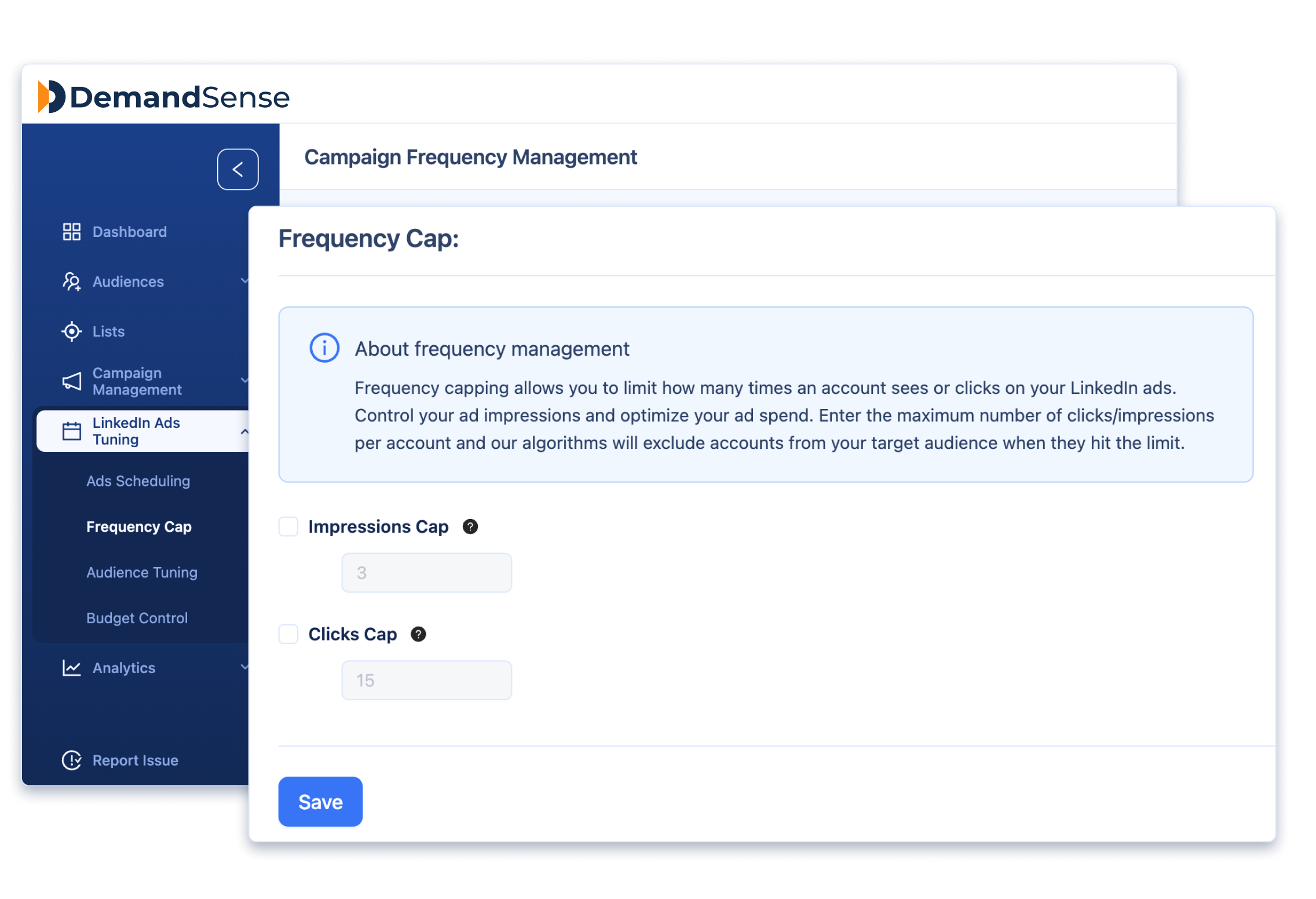
Frequency capping in DemandSense - Audience tuning: Beyond LinkedIn’s native breakdowns, DemandSense shows which industries, departments, or accounts convert and lets you exclude underperformers or scale winners with one click.

Audience tuning in DemandSense
Multi-Channel Activation
LinkedIn remains the core channel, but DemandSense can extend to Facebook and display or CTV networks by reusing the same account lists as custom audiences.
The idea is a connected journey: someone clicks a LinkedIn ad, visits your site, and later sees a follow-up elsewhere, all tracked inside DemandSense.
CRM/Data Integration & Engagement Insights

DemandSense is not only about ads. It tries to tie everything back to revenue.
It pushes engagement into your CRM and syncs with HubSpot and Salesforce so company records show LinkedIn impressions, clicks, and scores.
This gives sales signals such as “Acme viewed your pricing page after a LinkedIn click” and lets you attribute ad spend to the pipeline.
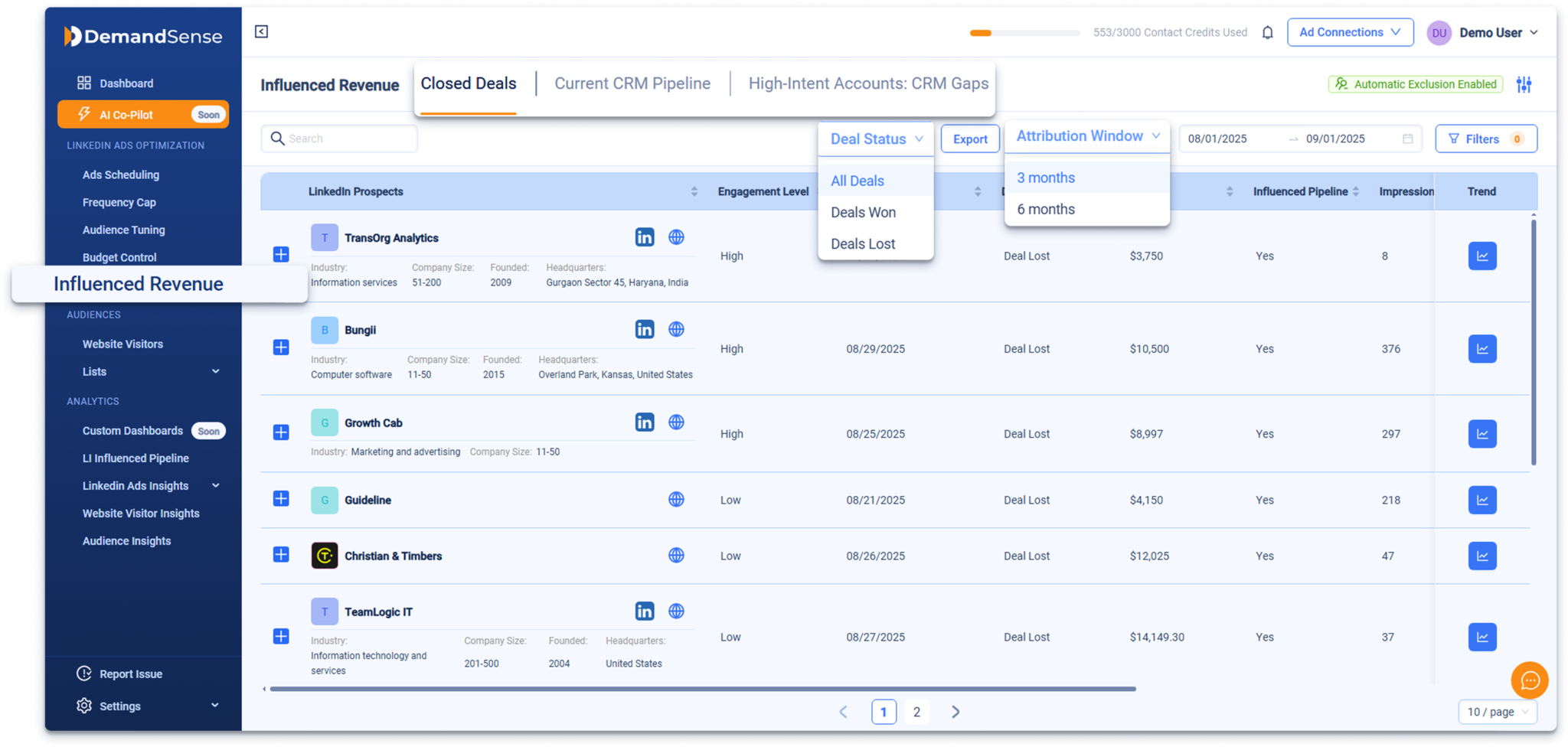
ZenABM likewise pushes account scores and engagement into CRM company records as properties, starting at $59 per month.

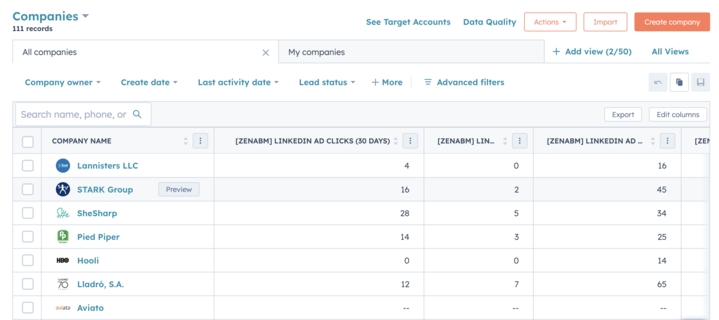


Hourly Reporting
DemandSense breaks down ad engagement, spend, and performance by hour:

DemandSense Pricing: How Much Does It Cost?
DemandSense pricing reflects how deeply you want intent baked into LinkedIn and cross-channel GTM.
The Basic plan at $99 per month gives marketers and sales a self-serve entry.
It includes audience tuning so users can see which companies interact with LinkedIn ads, plus ad scheduling, frequency capping, and richer reporting.
For companies that want intent data flowing directly from their website into sales, DemandSense Plus starts at $149 per month.
It adds everything in Basic plus 250 monthly data credits to identify anonymous website visitors or uncover leads from target accounts and unlocks the Website Visitor ID module.
Together, the tiers position DemandSense as an accessible LinkedIn intent tool with room to scale, provided you are comfortable with the credit model.
DemandSense vs. ZenABM: Pricing Comparison + Free Website Visitor Reveal Hack
The $99 and $149 plans look attractive until you notice the Plus tier’s 250 credit cap. Any decent traffic or outbound research can burn through that fast, and overages are where the real costs sit, turning a friendly sticker price into a classic intent data upsell.
ZenABM often comes out smarter, starting at about $59 per month for Starter, with the highest agency tier (unlimited, no credits) still under $6K per year.
You get what you actually need for LinkedIn ABM: account-level engagement tracking, account scoring, ABM stage tracking, automatic routing of hot accounts to BDRs, bi-directional CRM sync, custom webhooks, qualitative buyer intent, job title level engagement, and plug-and-play ROI dashboards.
ZenABM also gives you unlimited website visitor identification if you retarget site visitors with cheap LinkedIn text ads and read back which companies were served impressions.
You get deanonymization and awareness in one go.

User Impressions and Reviews
Public reviews for DemandSense are still sparse.
On G2, DemandSense currently has a single 5-star review from an agency user.
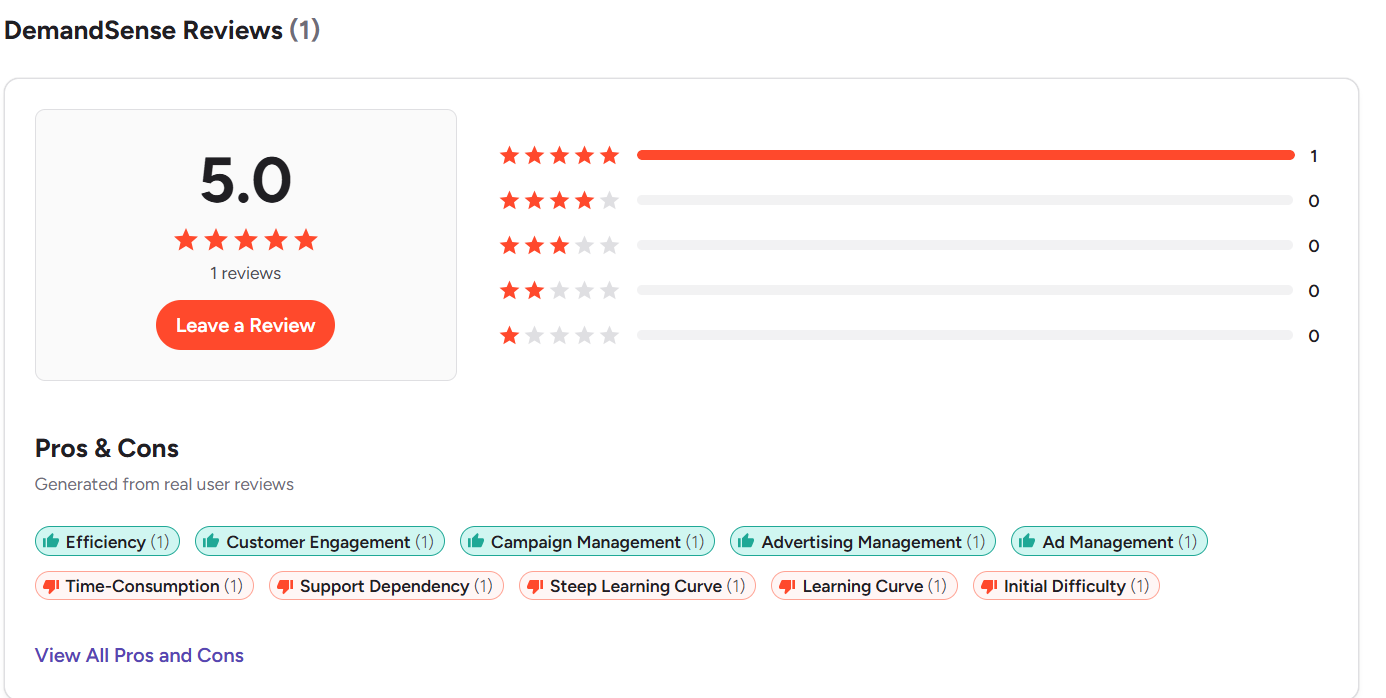

The reviewer praises the LinkedIn integration and ROI but warns that “there is a lot in the platform” and that you need time and possibly vendor help to set it up well.
Recotap vs. DemandSense: Key Differences
The key differences between Recotap and DemandSense are summarized here.
| Aspect | Recotap | DemandSense | Best suited for |
|---|---|---|---|
| Core positioning | LinkedIn first ABM platform covering data, campaigns, website personalization and analytics | LinkedIn centric demand gen and optimization platform for marketers and agencies | Teams choosing between a full ABM suite and a focused LinkedIn optimizer |
| Data foundation | Unifies CRM, MAP, website behavior and third party intent into a single account view | Uses LinkedIn and site tracking to unmask visiting companies and build intent signals | Stacks that need a unified ABM data layer vs those that mainly want visitor reveal |
| Intent model | ABM Signal Hub merges first party engagement with Bombora, G2 and TrustRadius intent and scores accounts | Relies on IP style matching and LinkedIn traffic patterns to infer which accounts are warm | Teams wanting combined first and third party intent vs those accepting IP driven identification tradeoffs |
| Primary channel focus | Advanced LinkedIn Ads orchestration plus website personalization and ABM programs | LinkedIn campaign controls with some extension to Facebook, display and CTV using shared audiences | LinkedIn and web led ABM vs LinkedIn first with optional cross channel retargeting |
| LinkedIn capabilities | 1 to 1 and 1 to many LinkedIn ABM campaigns, personalization at scale and journey based orchestration | Ad scheduling, frequency capping, smart budgeting and audience tuning on top of Campaign Manager | Teams that need deep creative and journey personalization vs those focused on performance tuning |
| Website personalization | Built in 1 to 1 landing pages and website personalization for target accounts | No native personalization, focuses instead on visitor identification feeding ad and CRM workflows | Orgs prioritizing on site experiences vs those prioritizing visitor reveal and retargeting |
| Visitor identification | Uses ABM Signal Hub and external intent but not marketed primarily as a visitor ID tool | Website Visitor ID or IntentID is a core selling point, gated behind credit based pricing | Teams that want visitor reveal as a main feature vs teams that see it as a secondary signal |
| Automation and journeys | Dynamic segments, AI journey staging and smart automations that trigger LinkedIn and sales plays | Automates hourly optimization, caps, budget shifts and segment based tuning | ABM programs built around account journeys vs performance focused ad operations |
| CRM and data integrations | Bi directional sync with Salesforce and HubSpot, plus MAP and sales tool integrations | Integrates with HubSpot and Salesforce to push LinkedIn engagement and visitor data into company records | Stacks that want ABM wide data sharing vs teams focused on LinkedIn to CRM feedback |
| Analytics and attribution | Revenue Impact dashboards that trace campaigns to pipeline and closed revenue by account | Reporting on hourly engagement, audience performance and revenue attribution from ads | Teams needing full ABM program impact vs those wanting ad and intent centric reporting |
| Pricing level | Standard at about 1,499 USD per month annual, Enterprise custom | Basic at 99 USD per month, Plus at 149 USD per month with 250 credits for visitor ID and overage potential | Mid market ABM budgets vs lean teams that can manage credit based pricing risk |
| Complexity and learning curve | Broad feature set, some complexity, but UX built to simplify ABM once configured | Feature rich for its size, with users noting you need time and guidance to configure it well | Teams ready for suite level setup vs teams ready to invest in a lighter but still involved tool |
| ABM breadth | Covers data, ads, website experiences, segmentation, automations and revenue analytics | Covers LinkedIn optimization, visitor ID, audience building and some cross channel activation | Companies choosing between full ABM coverage and a focused LinkedIn intent engine |
Recotap vs. DemandSense: So Which Is Better for ABM?
If your ABM motion is broader than just campaign tweaking, Recotap lands closer to a full program hub.
It pulls CRM, MAP, website and external intent into a single account profile, scores and stages accounts, then drives LinkedIn ads and web personalization from that data. Once configured, it feels like a lighter cousin of the big ABM suites, with enough journey and revenue reporting to justify a serious program.
DemandSense is narrower but sharper around LinkedIn operations.
It is built to reveal which companies visit and click, then optimize budgets, schedules and frequency at an account level.
The Plus tier adds visitor ID credits so you can link site traffic to companies and push that back into LinkedIn and CRM, with some extension into other channels when you want to reuse those audiences.
If you want a full ABM engine with web personalization and heavy intent mixing, Recotap makes more sense. If you are mainly annoyed with vanilla Campaign Manager and want smarter scheduling, capping and a layer of visitor reveal, DemandSense is the more surgical choice.
ZenABM as a LinkedIn First, First-Party Lean ABM Alternative
If you primarily care about first-party accuracy on LinkedIn, account scoring, ABM stages, CRM sync and revenue attribution, a lighter platform is easier to roll out.
This is where ZenABM comes in.
Even for teams running heavy multi-channel ABM, ZenABM adds a focused LinkedIn analytics and intent layer.
Account-Level LinkedIn Engagement Tracking


ZenABM connects directly to the official LinkedIn Ads API and records account-level data per campaign.
You see which companies view and engage with your ads using first-party LinkedIn data instead of IP or cookie matching. A Syft study suggests IP identification often peaks near 42 percent accuracy, so ZenABM treats ad engagement as the stronger intent signal.
Real Time Engagement Scoring & ABM Stages

ZenABM updates engagement scores continuously as accounts interact with your ads. You get a full touchpoint history and can define stages such as Identified, Aware, Engaged, Interested and Opportunity.


CRM Integration and Workflows
ZenABM syncs bi-directionally with HubSpot and supports Salesforce on higher plans. All LinkedIn metrics can be written as company properties inside your CRM.

When an account crosses your scoring threshold, ZenABM can update its stage and auto assign a BDR for timely outreach.

Intent Tagging and ABM Analytics
ZenABM lets you pull intent topics from LinkedIn campaigns and tag campaigns by feature, use case or offer.
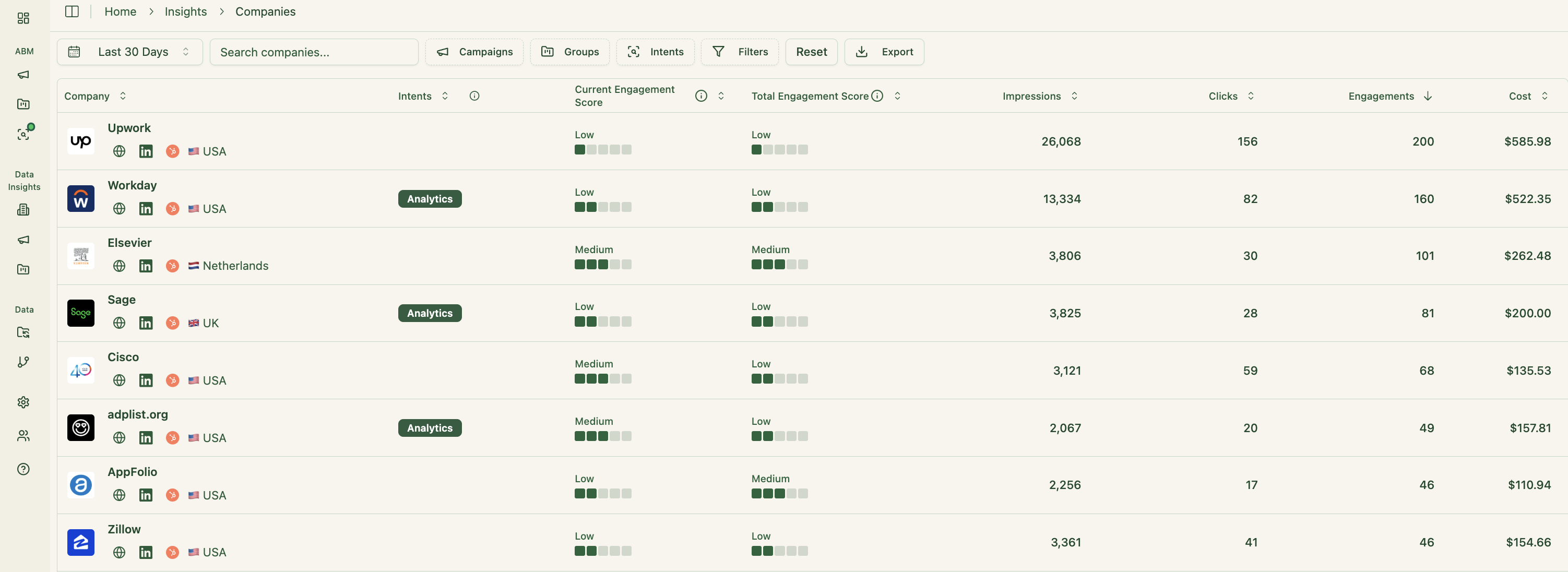
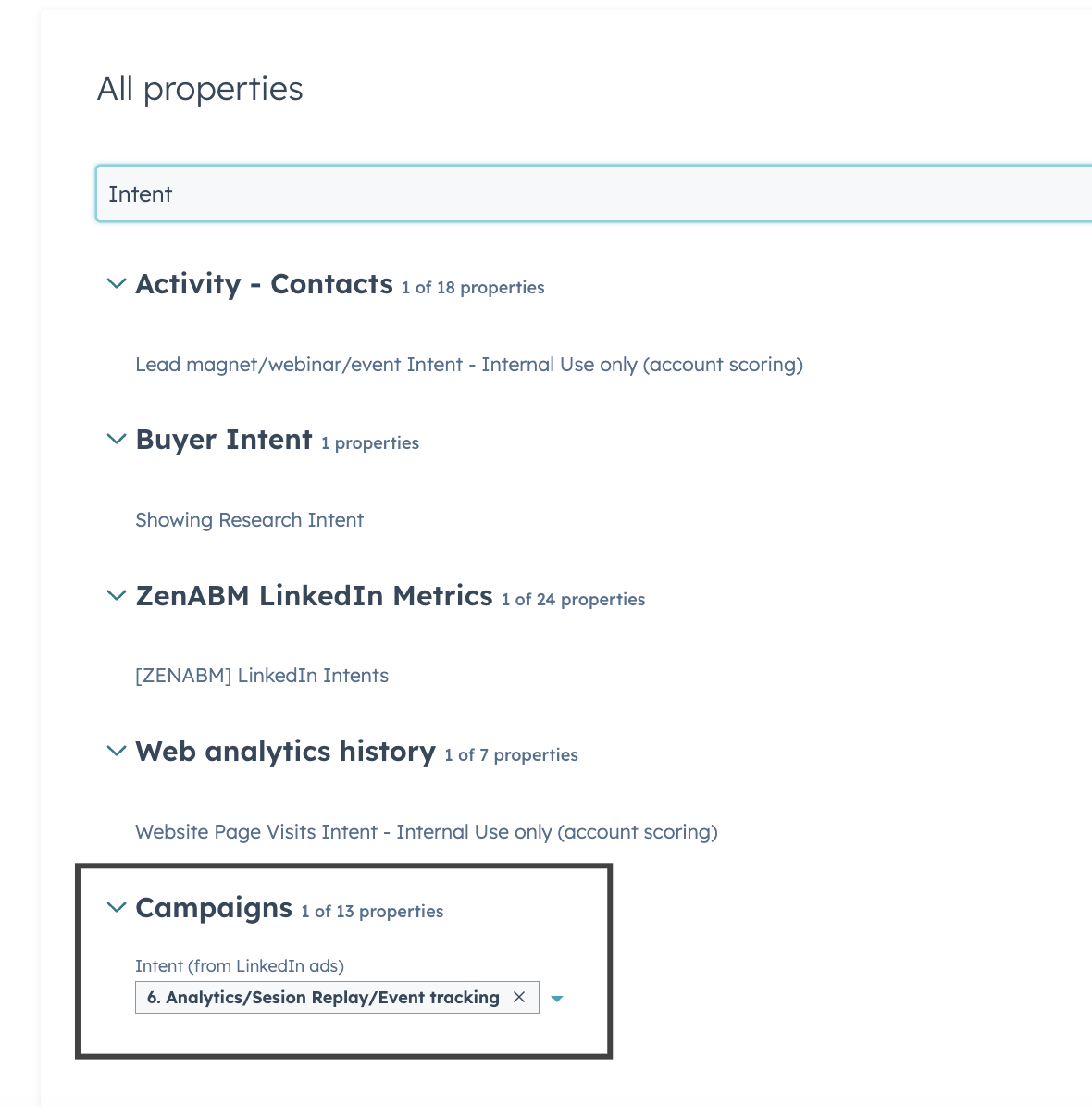
Its ABM dashboards connect LinkedIn ads to account engagement, stages and revenue. Because ZenABM tracks deal value and ad spend per company and campaign, it can calculate ROAS and pipeline per dollar automatically.
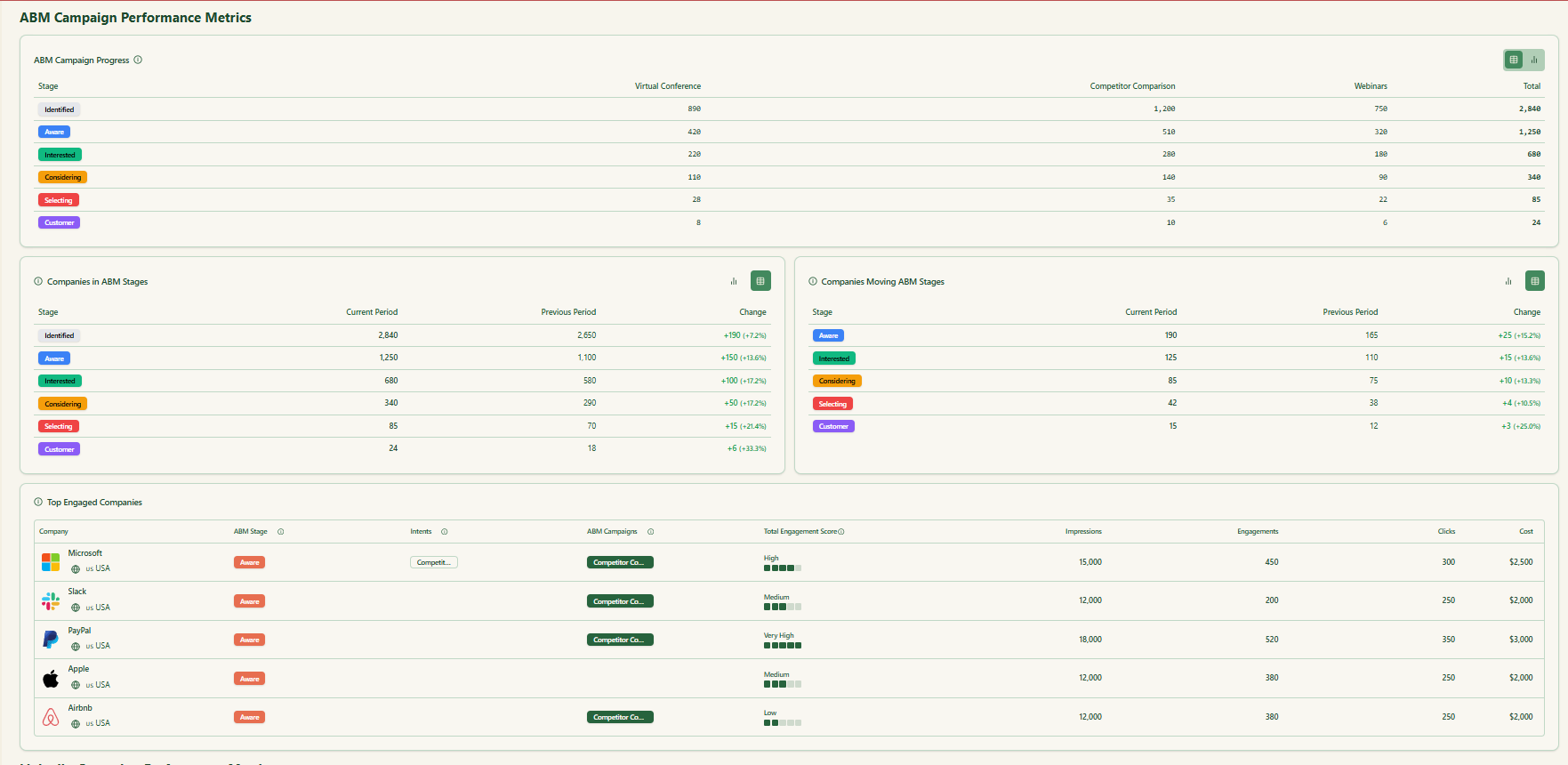

Webhooks, Job Title Analytics & Campaign Objects
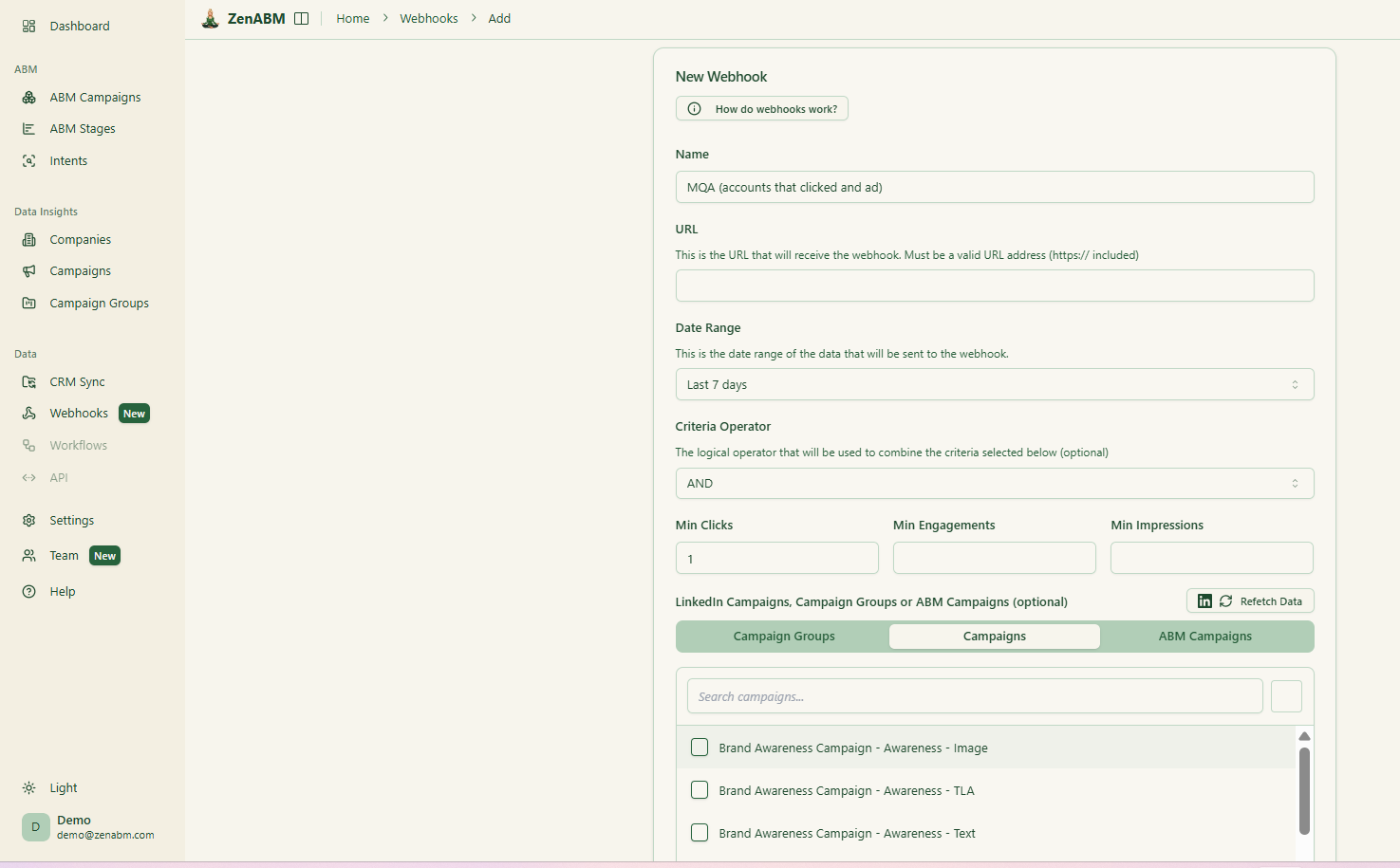
ZenABM webhooks send events into your stack for Slack alerts, enrichment flows and other automation.
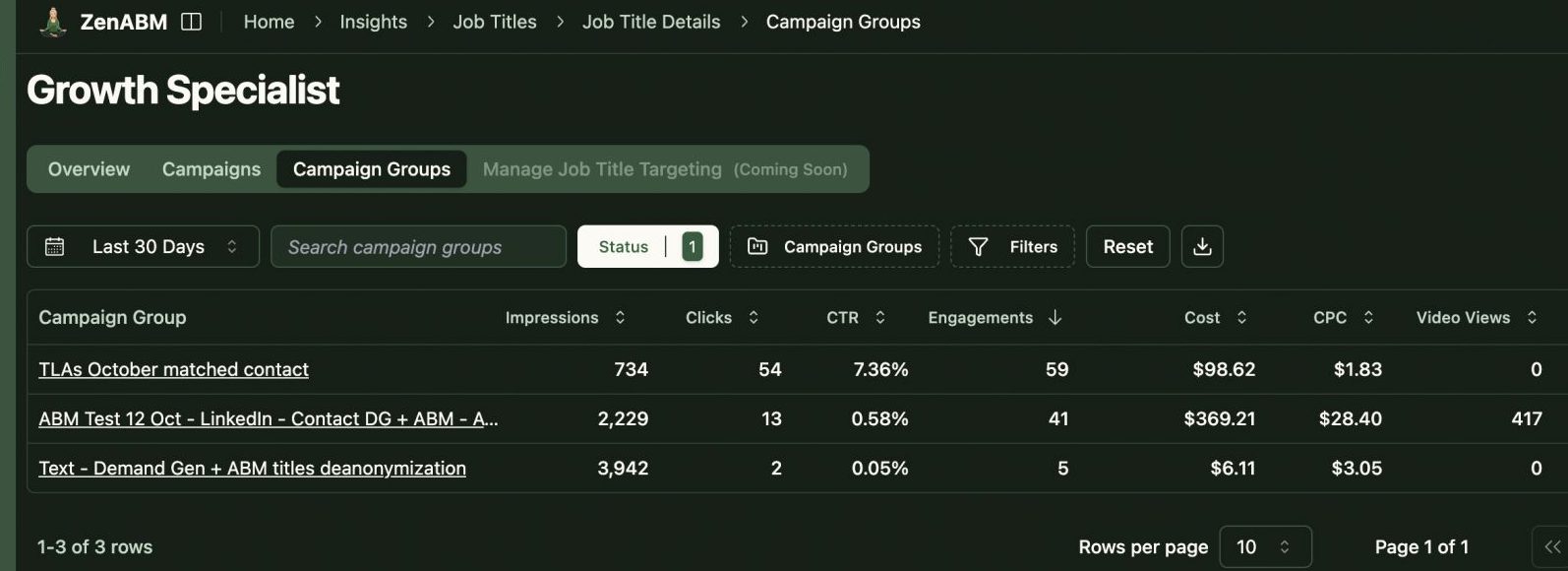
You can group LinkedIn campaigns into ABM campaign objects and view performance across markets, personas or creative clusters rather than juggling individual reports.
AI Chatbot & Multi-Client Workspace
ZenABM includes an AI chatbot on top of your LinkedIn API data and ABM model so you can ask questions like “Which accounts moved from Interested to Selecting last month?” or “What is my pipeline per dollar on retargeting campaigns?”
Agencies can use the multi-client workspace to run several ad accounts and ABM campaigns with separate dashboards and reporting without constant switching in Campaign Manager.
ZenABM Pricing
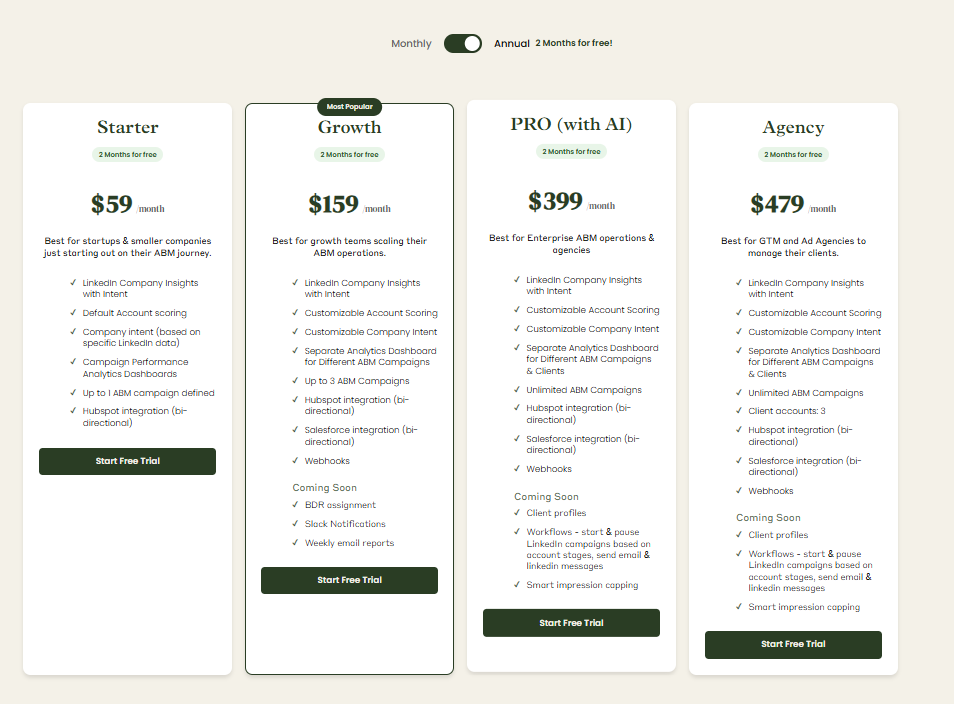
Plans start at $59 per month for Starter, $159 per month for Growth, $399 per month for Pro (AI) and $479 per month for Agency.
The Agency plan still stays under $6,000 per year, and all tiers include core LinkedIn ABM capabilities. Higher tiers mainly lift limits and add Salesforce sync.
Every plan comes with a 37-day trial.
Conclusion
Recotap operates as a full ABM platform.
It unifies internal and external intent data, scores and stages accounts, runs LinkedIn campaigns and personalized web experiences, then connects that activity back to pipeline and revenue.
If you want a LinkedIn first ABM suite that behaves like a lighter 6sense or Demandbase, Recotap fits that role, with pricing that reflects it.
DemandSense is closer to an intelligence and control layer on top of LinkedIn.
It concentrates on revealing which companies visit and click, then tweaking budgets, schedules, caps and audiences to squeeze more performance out of your existing campaigns and broaden to other channels when you want reuse, with a lower entry price but a credit-based visitor ID model.
If your real need is clean first-party LinkedIn engagement by company, simple ABM stages, CRM sync and plug and play ROAS dashboards, ZenABM hits the middle ground.
It gives you reliable company-level LinkedIn data direct from the API, automatic scoring and workflows inside HubSpot or Salesforce, and pricing that starts at 59 dollars per month without credit traps, while still staying useful even if you later add Recotap or DemandSense around it.

